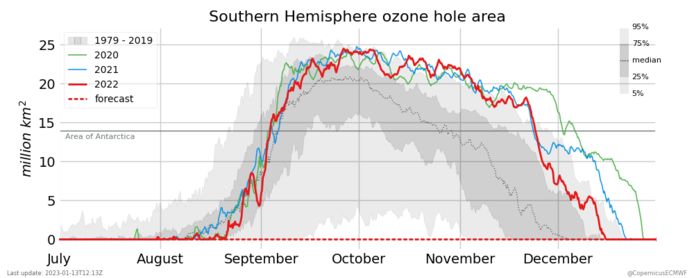The ozone layer plays a crucial role in blocking harmful ultraviolet rays from the sun. For a long time, the ozone hole seemed to be shrinking thanks to the ban on CFCs. but Latest results Scientists from New Zealand suggest that the ozone layer may no longer recover. In fact, over the past three years (2020-2022), large, long-lasting holes have reappeared in the ozone layer over Antarctica. Factors such as forest fires, volcanic eruptions and greenhouse gas emissions may be responsible.
The ozone layer is located at an altitude ranging between 11 and 40 kilometers above the Earth’s surface. This layer acts as a filter for most of the sun’s ultraviolet rays, which can cause skin cancer. Since the 1970s, chemicals (chlorofluorocarbons) have been reducing ozone levels, resulting in large annual gaps. These are mainly located over Antarctica. The 1987 Montreal Protocol banned these CFCs. With the entry into force of this international environmental cooperation, the ozone layer over Antarctica is expected to recover by 2066.
Despite the decline in CFCs, researchers from New Zealand now report in a new study published in Nature Communications that there is no significant reduction in the Antarctic ozone hole. They say the center of the hole shows a decrease in ozone over time. Six of the past nine years have been characterized by low ozone levels and large ozone holes.
Read more below the picture

Scientists point out that weather changes, perhaps due to climate change, are masking some of the recovery. But they did not investigate this in detail. They say a combination of wildfires, volcanic aerosols and greenhouse gas emissions explains the recent setbacks, with record-sized ozone holes appearing over Antarctica in the spring since 2020. Hannah Kicinich, lead author of the study Confirms The Montreal Protocol and CFC reductions remain on track. But their findings show that other factors may be contributing to recent ozone problems.
However, scientist Martin Jucker attaches little credibility to the study’s findings. He points to The conclusions depend largely on the large ozone holes of 2020-2022. Existing literature has already found explanations for these large ozone holes, such as smoke from the 2019 wildfires, volcanic eruptions, and a connection between the polar stratosphere and a rare triple La Niña in 2020-2022. Additionally, the analysis ignored data from 2002 and 2019, years in which smaller ozone holes formed due to polar vortex disruption.
Read more below the picture

Previous studies showed that the ozone hole increased by 10 percent in 2020 due to widespread forest fires on “Black Saturday” in Australia. The eruption of the Hunga-Tonga-Hunga-Haapai volcano off the coast of Tonga in 2022 is also believed to have affected modern ozone levels. “It is not clear why the authors chose to exclude data from 2002 and 2019 from the study, but not data for 2020-2022, when all these years were affected by very special and rare events,” Joker said.
“Ozone can lead to health problems”: Why we can’t do without ozone and it can still have an impact on our health (+)
The hole in the ozone layer began to form exceptionally early this year: “its area is already 16 million square kilometers.”
The return of the “polar vortex” over the North Pole: what is it? What are the consequences? Will there be a harsh winter? The expert explains (+)
Free unlimited access to Showbytes? Which can!
Log in or create an account and never miss a thing from the stars.

“Creator. Award-winning problem solver. Music evangelist. Incurable introvert.”







More Stories
British military spy satellite launched – Business AM
Alarming decline in the Caspian Sea
Lithuania begins construction of military base for German forces